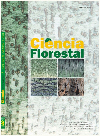
|
Ciência Florestal
Centro de Pesquisas Florestais - CEPEF, Departamento de Ciências Florestais - DCFL, Programa de Pós Graduação em Engenharia Florestal - PPGEF
ISSN: 0103-9954
EISSN: 0103-9954
Vol. 27, No. 1, 2017, pp. 339-354
|
 Bioline Code: cf17028
Bioline Code: cf17028
Full paper language: Portuguese
Document type: Note
Document available free of charge
|
|
|
Ciência Florestal, Vol. 27, No. 1, 2017, pp. 339-354
| en |
DIAGNOSIS OF THE FORESTS PLANTED IN RIVER BASIN OF ‘PARDO’ RIVER, RIO GRANDE DO SUL STATE
Farias, Jorge Antonio de; Schneider, Paulo Renato & Biali, Leonardo Job
Abstract
The present study aims to make a diagnosis of the forests planted in the basin of ‘Pardo’ river (Rio Pardo),
in RS state, by contemplating the characterization of properties, of forestations, and of the availability and
consumption of wood in the region. The area of reach of the study is in the central region of Rio Grande
do Sul state, which main economy is the tobacco crop, enclosing 13 cities that compose the performance
area of the Management Committee of Rio Pardo Hydrographic Basin. The data collect were conducted
during year 2008. In order to determine the size of the sample, it was made a sampling with its probability
proportional to the size, where the criterion of the sample unity distribution took in consideration the
numbers of trees per city and, inside the cities, the number of trees per class of property size. The sampling
method utilized on the forest inventory was by Prodan, in addition to interviews taken with the producers.
The region is characterized by small agricultural producers, and 61.4% of the firewood used in the cure of
tobacco leaves is acquired from others, moreover, the majority of the forestation possess reduced spacing
(2.26 m²/plant) and low survival indices, in order of the 34.4% after 7 years of the plantation. The wooden
current supply is of 2,781.069 m³, what guarantees a supplying for only 3.5 years. The collected data allow
to evidence that the resources necessary to invest in the self-sufficiency of firewood for the crop tobacco,
are of R$ 12,250,000,00, that could be placed annually, during seven years, equivalent the rotation in simple
coppice, resulting in an area of 80 ha/year/city.
Keywords
family farming; forest inventory; prodan method; forest economy
|
| |
| pt |
DIAGNÓSTICO DAS FLORESTAS PLANTADAS NA BACIA HIDROGRÁFICA DO RIO PARDO - RS
Farias, Jorge Antonio de; Schneider, Paulo Renato & Biali, Leonardo Job
Resumo
O presente estudo visa fazer um diagnóstico das florestas plantadas na Bacia Hidrográfica do Rio Pardo -
RS, contemplando a caracterização das propriedades, dos florestamentos, e a disponibilidade e o consumo
de madeira na região. A área de abrangência do estudo fica na região central do Rio Grande do Sul, cuja
economia principal é a fumicultura, abrangendo 13 municípios que compõem a área de atuação do Comitê
de Gerenciamento da Bacia Hidrográfica do Rio Pardo. A coleta dos dados foi conduzida no decorrer do
ano de 2008. Para a determinação do tamanho da amostra, foi feita uma amostragem com probabilidade
proporcional ao tamanho, sendo que o critério de distribuição das unidades amostrais levou em consideração
o número de árvores por município e, dentro dos municípios, o número de árvores por classe de tamanho
de propriedade. O método de amostragem utilizado no inventário florestal foi o de Prodan, além de
ter sido feitas entrevistas com os produtores. A região é caracterizada por pequenos produtores rurais,
e 61,4% da lenha utilizada na cura das folhas de tabaco é adquirida de terceiros, além disso, a maioria
dos florestamentos possui espaçamentos reduzidos (2,26 m²/planta) e baixos índices de sobrevivência, na
ordem 34,4% após 7 anos do plantio. O estoque atual de madeira é de 2.781.069 m³, o que garante um
abastecimento para apenas 3,5 anos. Os dados levantados permitem constatar que os recursos necessários
para investir na autossuficiência de lenha para a fumicultura, são de R$ 12.250.000,00, que poderiam ser
alocados anualmente, durante sete anos, equivalente à rotação em talhadia simples, resultando em uma área
de 80 ha/ano/município.
Palavras-chave
agricultura familiar; inventário florestal; método de Prodan; economia florestal
|
| |
© Copyright 2017 - Ciência Florestal
Alternative site location: http://cascavel.ufsm.br/revistas/ojs-2.2.2/index.php/cienciaflorestal/index
|
|
